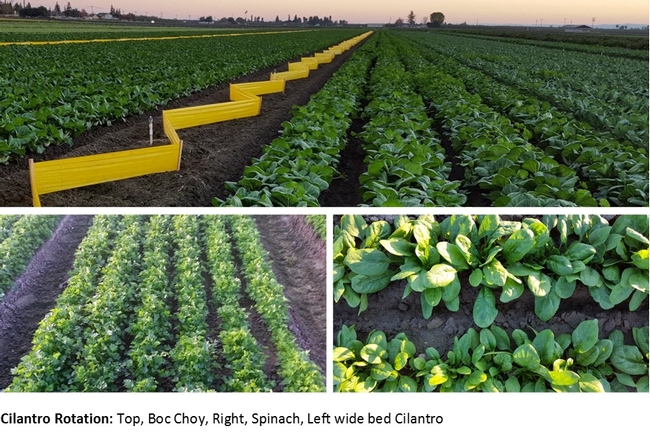I've reposted (with permission) Stephen Flanagan's article from The IR-4 Project. Check out the whole issue "Volume 48 No.1 Winter 2017" for several interesting articles from a program that is incredibly important to pest management in specialty crop agriculture.
Take care, Brad
Plant-back Studies - Another Avenue for IR-4 to Address Specialty Crop Growers' Needs
- by Stephen Flanagan, IR-4 Western Region Assistant Research Field Coordinator
Western growers approached IR-4 to remove the 12 month plant-back restrictions for the herbicide CAPAROL® (containing the active ingredient prometryn) which is registered for pre-emergent use on cilantro. Registrations to remove plant-back restrictions are critical for southern tier and western growers who plant multiple crops per season. A plant-back restriction on an herbicide label limits how quickly a rotational crop can be planted following the herbicide use on a labeled crop. The current Caparol registration is generally useful to vegetable growers to control weeds in cilantro, but as a 60-90 day crop, a grower wants to plant any number of other vegetable crops shortly after cilantro harvest. Cilantro is mature in about 50 days and is harvested once or multiple times. Then the field is quickly plowed and prepared for the next crop.
The following crop after cilantro at Ratto Brothers in Modesto, California might be bok choy, spinach, rutabaga, parsley or any number of specialty vegetable crops. Caparol is safe and effective for weed control on cilantro, but the label restrictions state that rotational crops may not be planted back sooner than 5 months (cabbage and carrots), or 8 months (onions and red beets), or 12 months for crops like spinach, peppers and brussel sprouts. If you are a grower of a diverse set of vegetable crops, these restrictions limit the usefulness of Caparol on cilantro. The herbicide is registered and safe on the crop you want to grow, but the restrictions for the following crop make the product unusable for your current crop.
This practical conundrum became the basis for four IR-4 residue projects and one IR-4 efficacy project in 2017. The efficacy project being conducted by Steve Fennimore with UC Davis will be looking at crop safety to spinach, Chinese cabbage, broccoli and peppers following a Caparol application to cilantro. These are four of the most important rotational crops following Cilantro that were selected in consultation with Hank Giclas at the Western Growers Association. Steve Fennimore will apply Caparol and then plant the rotational crops at 60, 90, & 120 days after the herbicide application. The rotational crops are then evaluated for any phytotoxicity (plant damage) that has occurred from the previously applied herbicide. This efficacy data will provide confidence that the rotational crops can be labeled for the shorter plant-back interval.
Along with demonstrating that the rotational crops can be safely grown following a Caparol application to cilantro, tolerance data (the level of prometryn found in or on these rotational crops) will be established through crop residue studies. For the 2017 field season, IR-4 will specifically run residue trials on spinach, cabbage, broccoli and peppers. The IR-4 residue trials will be submitted to EPA in order to establish indirect or inadvertent residue tolerances for prometryn when planted following a labeled crop. The concept of an inadvertent tolerance covers this particular situation where the following crop may have residues from a compound that was not directly applied to that crop.
Carefully coordinated work between growers, extension weed specialists, and IR-4 will provide the technical support and data for a modification of the Caparol label. These modifications will address shortening the plant-back interval for the rotational crops following cilantro. To that effect the residue trials are designed around 60-day and 90-day plant-back intervals to identify the shortest possible interval. Conducting IR-4 studies for a grower's plant-back needs may seem a little out of the ordinary, but these studies fill an important niche to improve a product's use in the field. The Caparol cilantro plant-back project is another twist on IR-4's multifaceted work to support the needs of US specialty crop growers and food production.